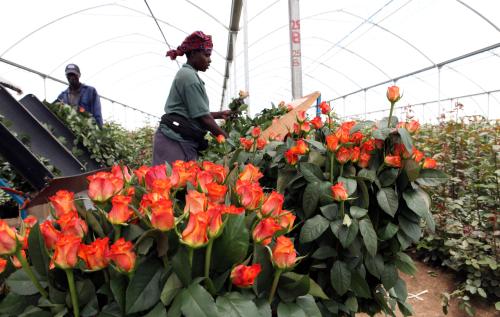Introduction
Structural change is taking place in Africa, but with a pattern that is distinct from the historical experience of the industrialized countries and contemporary East Asia: In short, export-led manufacturing is playing a much smaller role in the structural transformation of Africa’s economies. Services—some with quite low productivity—absorb the bulk of African workers leaving agriculture and moving to cities. These changes reflect the impact of technological progress and a changing global marketplace on Africa’s prospects of industrialization.
At the same time, reductions in transport costs and advancements in information and communications technology have led to the creation of services and agri-businesses that share firm characteristics with manufacturing.1 Like manufacturing, they are tradable and have high value added per worker. These sectors have the capacity for learning and productivity growth, and some exhibit scale and agglomeration economies (Ebling and Janz, 1999; Ghani and Kharas, 2010). For lack of a better term, these are termed “industries without smokestacks” (IWOSS) to distinguish them from traditional, “smokestacks” industries (Page, 2020). These IWOSS may have the potential to fulfill the role traditionally assumed to be that of manufacturing in structurally transforming an economy. In this paper, we consider whether these sectors have the potential to generate the employment required to address high and growing unemployment in South Africa specifically.
South Africa has been in a long-run, low-growth trap since the onset of democratic rule in 1994. The result has been modest reductions in household poverty levels, coupled with high and rising inequality. The labor market is the primary driver of this rise in inequality, with a significant number of zero earners in the income distribution. South Africa’s unemployment rate and, more specifically, its youth2 unemployment rate—at 29 percent and 56 percent, respectively—are considerably higher than comparable upper-middle-income countries or other countries in sub-Saharan Africa and have been on a clear upward trend since 2008.
South Africa’s current economic growth trajectory is not producing the volume and type of jobs required to reverse these trends in inequality and unemployment. Manufacturing, traditionally one of the largest employers of low-skilled workers, has experienced an annual growth rate of less than 1 percent between 2010 and 2018. Instead, there has been a shift toward services sectors.
This shift toward services—without manufacturing growth—is characteristic of much of Africa. South Africa, however, is an outlier among other African countries. Elsewhere in Africa, the move has been largely characterized by a shift into low-productivity services, often in the informal sector. In South Africa, the shift has been to financial and community services, which are relatively high-productivity sectors in which jobs are more likely to be high-skilled. The shift towards formal sector services has, thus, not generated the jobs needed to reduce unemployment and inequality.
In the absence of growth in the manufacturing sector, South Africa already appears to be on a path of structural transformation characterized by a shift toward IWOSS, more specifically those in financial, business, and community services. However, within the broader IWOSS category, there are however a number of other sectors that may be better suited to address South Africa’s employment and inequality challenges.
In this paper, we consider the case for specific IWOSS sectors to drive structural transformation that is inclusive and able to generate employment across the skills distribution. We also consider the skill requirements for the potential of these sectors to be realized. The paper focuses on the following key questions:
- What are the IWOSS sectors best poised for economic growth and job creation in South Africa?
- What are the constraints to the development of IWOSS in South Africa?
- What is the employment potential of IWOSS sectors for youth in South Africa?
To consider these questions, we provide a quantitative analysis of labor force survey data and conducted a survey of firms operating in IWOSS. For the quantitative, a series data on gross valueadded (GVA) and individual labor market activities data obtained from Statistics South Africa.3 We also make use of O*NET, a standardized database of skill requirements from the United States for over 1,000 occupations (O*NET, 2019). The O*NET database provides information on numerous measures such as skills, knowledge, abilities, and education levels required for a particular occupation (O*NET, 2019). The firm survey on employment potential and skill requirements supplements the results of the quantitative analysis. These firm interviews were conducted in the tourism, agro-processing, horticulture, and transit trade sectors. These four IWOSS sectors were selected based on their ability to create several types of jobs across the skills spectrum in South Africa.
The paper proceeds as follows. Section 2 provides an overview of the South African economy. Section 3 considers patterns of growth and structural transformation in South Africa. Section 4 considers the employment composition of IWOSS sectors in comparison to non-IWOSS sectors in South Africa. Section 5 provides a closer look at four specific IWOSS sectors, noting their potential for growth and employment through an understanding of the value chains of these sectors, as well as the constraints to growth in these sectors. Section 6 provides a high-level analysis of the employment potential of IWOSS sectors. Section 7 supplements the employment potential and skill gap analysis of Section 6 with the findings of interviews conducted with 18 firms across the four chosen IWOSS sectors. Section 8 discusses policy recommendations for enabling growth in IWOSS sectors. Section 9 concludes.
-
Footnotes
- See Baumol (1985) and Bhagwati (1984).
- In this report, youth are considered to be individuals aged between 15 and 24.
The Brookings Institution is committed to quality, independence, and impact.
We are supported by a diverse array of funders. In line with our values and policies, each Brookings publication represents the sole views of its author(s).









